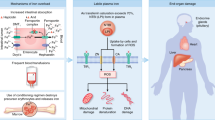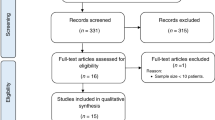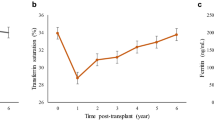Abstract
Iron overload (IO) is associated with free radical generation and tissue damage. Our main objective was to ascertain if very high levels (VHL) of ferritin (⩾3000 μg/l) and transferrin saturation (TS) ⩾100% during conditioning had an impact on overall survival (OS) and transplant-related mortality (TRM) after a haematopoietic stem cell transplantation (HSCT). Levels of ferritin and TS were measured at days −7 and −4, respectively, in 25 patients who underwent HSCT after CY/TBI. The group consisted of 20 men and five women with a median age of 40 years. Fifteen patients were autotransplanted and 10 allotransplanted. Nine of them had a diagnosis of AL, six of CML and 10 of lymphoma. Thirteen of them were in early and 12 in advanced status of disease. VHL of ferritin and TS ⩾100% were associated with a decreased OS (P = 0.001 and P = 0.006, respectively) and an increased TRM (P = 0.003 and P = 0.004, respectively) in univariate survival analysis. Both variables remained significant at multivariate analysis for OS (P = 0.03 and 0.02, respectively) and TS was an independent factor for TRM (P = 0.01). Ferritin was very close to achieving statistical significance for TRM (P = 0.06) in multivariate analysis. In conclusion, VHL of ferritin and TS ⩾100% at conditioning are associated with an increase in toxic deaths after transplant.
This is a preview of subscription content, access via your institution
Access options
Subscribe to this journal
Receive 12 print issues and online access
$259.00 per year
only $21.58 per issue
Buy this article
- Purchase on Springer Link
- Instant access to full article PDF
Prices may be subject to local taxes which are calculated during checkout

Similar content being viewed by others
References
Hershko C, Graham G, Bates GW, Rachmilewitz EA . Non-specific serum iron in thalassaemia: an abnormal serum iron fraction of potential toxicity Br J Haematol 1978 40: 255 263
Franchini M, Gandini G, Gironcoli M et al. Safety and efficacy of subcutaneous bolus injection of deferoxamine in adult patients with iron overload Blood 2000 95: 2776 2779
Bradley SJ, Gosriwitana I, Srichairatanakool S et al. Non-transferrin-bound iron induced by myeloablative chemotherapy Br J Haematol 1997 99: 337 343
Sahlstedt L, Ebeling F, Bonsdorff L et al. Non-transferrin-bound iron during allogeneic stem cell transplantation Br J Haematol 2001 113: 836 838
Gordon LI, Brown SG, Tallman MS et al. Sequential changes in serum iron and ferritin in patients undergoing high-dose chemotherapy and radiation with autologous bone marrow transplantation: possible implications for treatment related toxicity Free Rad Biol Med 1995 18: 383 389
Strasser SI, Kowdley KV, Sale GE, McDonald GB . Iron overload in bone marrow transplant recipients Bone Marrow Transplant 1998 22: 167 173
Halliwell B, Gutteridge JMC, Cross CE . Free radicals, antioxidants, and human disease: where are we now? J Lab Clin Med 1992 119: 598 620
Carmine TC, Evans P, Bruchelt G et al. Presence of iron catalytic for free radical reactions in patients undergoing chemotherapy: implications for therapeutic management Cancer Lett 1995 94: 219 226
Tomás JF, Pinilla I, Garca-Buey ML et al. Long-term liver dysfunction after allogeneic bone marrow transplantation: clinical features and course in 61 patients Bone Marrow Transplant 2000 26: 649 655
Bullen JJ . The significance of iron in infection Rev Infect Dis 1981 3: 1127 1138
Iglesias-Osma C, Gonzalez-Villaron L, San Miguel JF et al. Iron metabolism and fungal infections in patients with haematological malignancies J Clin Pathol 1995 48: 223 225
Brandhagen DJ, Alvarez W, Therneau TM et al. Iron overload in cirrhosis-HFE genotypes and outcome after liver transplantation Hepatology 2000 31: 456 460
Maertens J, Demuynck H, Verbeken EK et al. Mucormycosis in allogeneic bone marrow transplant recipients: report of five cases and review of the role of iron overload in the pathogenesis Bone Marrow Transplant 1999 24: 307 312
de la Serna J, Bornstein R, Garca-Bueno MJ, Lahuerta-Palacios JJ . Iron depletion by phlebotomy with recombinant erythropoietin prior to allogeneic transplantation to prevent liver toxicity Bone Marrow Transplant 1999 23: 95 97
Author information
Authors and Affiliations
Rights and permissions
About this article
Cite this article
Altès, A., Remacha, A., Sureda, A. et al. Iron overload might increase transplant-related mortality in haematopoietic stem cell transplantation. Bone Marrow Transplant 29, 987–989 (2002). https://doi.org/10.1038/sj.bmt.1703570
Received:
Accepted:
Published:
Issue Date:
DOI: https://doi.org/10.1038/sj.bmt.1703570
Keywords
This article is cited by
-
Early transplantation-related mortality after allogeneic hematopoietic cell transplantation in patients with acute leukemia
BMC Cancer (2021)
-
Impact of pretransplant red cell transfusion on outcome after allogeneic stem cell transplantation in adult patients with severe aplastic anemia
Bone Marrow Transplantation (2016)
-
Ferritin as an early marker of graft rejection after allogeneic hematopoietic stem cell transplantation in pediatric patients
Annals of Hematology (2016)
-
A prospective cohort study of the feasibility and efficacy of iron reduction by phlebotomy in recipients of hematopoietic SCT
Bone Marrow Transplantation (2015)
-
Differing impacts of pretransplant serum ferritin and C-reactive protein levels on the incidence of chronic graft-versus-host disease after allogeneic hematopoietic stem cell transplantation
International Journal of Hematology (2013)



